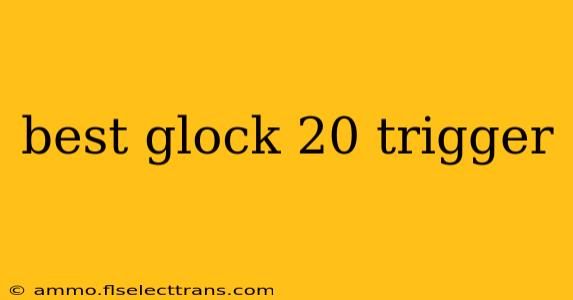The Glock 20, chambered in the powerful 10mm Auto cartridge, is a formidable handgun favored by many. However, one area where many Glock owners seek improvement is the trigger. The factory trigger, while functional, can often feel gritty, heavy, and somewhat imprecise. Upgrading the trigger can significantly enhance both the shooting experience and accuracy. This guide will explore the best Glock 20 triggers available, considering various factors like feel, price, and ease of installation.
Understanding Glock 20 Trigger Components and Upgrades
Before diving into specific trigger options, it's crucial to understand the key components involved in a Glock trigger system. The primary parts that influence the trigger pull are:
-
Connector: This component dictates the trigger's reset and overall feel. Replacing the connector is often the simplest and most cost-effective way to improve the trigger. Lighter connectors generally result in a shorter reset and a lighter pull weight.
-
Trigger Bar: This is the part of the trigger mechanism that interacts directly with the firing pin. Upgrading to an aftermarket trigger bar can improve smoothness and reduce creep.
-
Trigger Shoe: This is the part of the trigger you actually press. Aftermarket trigger shoes often feature improved ergonomics and a more comfortable shape.
-
Complete Trigger Kits: Several manufacturers offer complete trigger kits that replace multiple components, providing a comprehensive upgrade.
Top Glock 20 Trigger Choices: A Detailed Review
Choosing the "best" Glock 20 trigger depends heavily on individual preferences and shooting style. Some shooters prioritize a crisp, light trigger for competition, while others prefer a slightly heavier trigger for self-defense. Here's a breakdown of some highly regarded options:
1. Ghost Inc. Glock Trigger
Ghost Inc. is a well-known manufacturer of Glock aftermarket parts, and their triggers are consistently praised for their smooth, crisp breaks. They offer various connectors and trigger bars, allowing for customization to achieve a desired pull weight. Installation is generally straightforward, even for novice gunsmiths.
Pros: Smooth pull, crisp break, numerous options for customization, relatively affordable.
Cons: May require minor fitting depending on your specific Glock 20.
2. Apex Tactical Specialties Glock Trigger
Apex Tactical Specialties is another reputable manufacturer of Glock upgrades. Their triggers are known for their reliability and consistent performance. They often incorporate features such as a smoother trigger bar and a reduced trigger pull weight.
Pros: High quality, reliable performance, excellent reputation.
Cons: Typically more expensive than some other options.
3. Zev Technologies Glock Trigger
Zev Technologies is a high-end Glock tuner, and their triggers often come with enhanced features such as a reduced trigger pull, improved reset, and enhanced ergonomics. These are usually a more premium option than others listed here.
Pros: Exceptional quality, refined feel, improved ergonomics.
Cons: Higher price point.
Factors to Consider When Choosing a Glock 20 Trigger
-
Your skill level: If you're new to gunsmithing, a simpler connector replacement might be a better starting point than a complete trigger kit.
-
Your budget: Trigger upgrades range in price from relatively inexpensive connectors to more expensive complete kits.
-
Your shooting style and purpose: The ideal trigger for competition might differ from the ideal trigger for self-defense.
-
Legality: Be aware of any local or state laws regarding modifying firearms.
Conclusion: Finding the Perfect Trigger for Your Glock 20
Ultimately, selecting the best Glock 20 trigger is a matter of personal preference. Research the options thoroughly, read reviews, and consider your individual needs and shooting style. Investing in a high-quality trigger can significantly improve your shooting accuracy and overall enjoyment of your Glock 20. Remember to always prioritize safety when working on your firearm and consult a qualified gunsmith if you are unsure about any aspect of the installation process.

